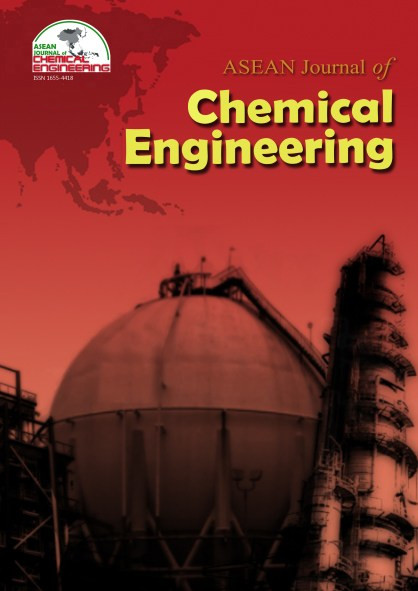Biosynthesis and Kinetics of Silver Nanoparticles Formation by Reduction using Banana Kepok (Musa balbisiana) Peel Extract
Abstract
Biosynthesis and silver nanoparticles formation during the reduction of AgNO3 were carried out by using an aqueous peel extract of banana kepok (Musa balbisiana) as a stabilizing agent. The formation of the stable silver nanoparticles with different concentration of AgNO3 has resulted in mostly spherical particles. The Ultraviolet-Visible spectrophotometer, Transmission Electron Microscopy, X-Ray Diffractometer were used to characterize these biosynthesized silver nanoparticles. The spherical shaped nanoparticles were uniformly distributed with the range diameter of 5 to 50 nm and the particles were naturally crystallized with the crystal structure of the face-centered cubic geometry. Additionally, the kinetics of the formation process of silver nanoparticles was observed by the UV-Vis spectrophotometer. Based on the kinetic functions, the reduction process of banana peel extract had a constant formation rate of the autocatalytic process at 4.35 x 10-4 /s.
References
2. Annamalai, J., & Nallamuthu, T. (2016). Green synthesis of silver nanoparticles: characterization and determination of antibacterial potency. Applied Nanoscience 6, 259.
3. Dauthal, P. and Mukhopadhyay, M. (2016) Noble Metal Nanoparticles: Plant- Mediated Synthesis, Mechanistic Aspects of Synthesis, and Applications. Industrial & Engineering Chemistry Research, 55(36), 9557.
4. Gudikandula, K. and Maringanti, S.C. (2016) Synthesis of silver nanoparticles by chemical and biological methods and their antimicrobial properties. Journal of Experimental Nanoscience , 11(9), 714.
5. Ibrahim, H.M.M. (2015) Green synthesis and characterization of silver nanoparticles using banana peel extract and their antimicrobial activity against representative microorganisms. Journal of Radiation Research and Applied Sciences. 8, 265.
6. Khan, P.U., Chen, Y., Khan, N.U., Khan, Z.U.H., Khan, A.U., Ahmad, A., Tahir, K., Wang, L., Khan, M.R., Wan, P. (2016) Antioxidant and catalytic applications of silver nanoparticles using Dimocarpus longan seed extract as a reducing and stabilizing agent. Journal of Photochemistry and Photobiology B: Biology, 164, 344.
7. Krithiga, N., and Jayachitra, A., (2015) Green Synthesis of Silver Nanoparticles Using Leaf Extracts of Clitoria ternatea and Solanum nigrum and Study of Its Antibacterial Effect against Common Nosocomial Pathogens, Journal of Nanoscience, 928204, 1.
8. Kuppusamy, P., Yusoff, M.M., Maniam, G.P., and Govindan, N. (2016) Biosynthesis of metallic nanoparticles using plant derivatives and their new avenues in pharmacological applications – An updated report. Saudi Pharmaceutical Journal. 24, 473.
9. Logeswari, Sivagnanam Silambarasan, Jayanthi Abraham (2015) Synthesis of silver nanoparticles using plants extract and analysis of their antimicrobial property Peter. Journal of Saudi Chemical Society. 19, 311.
10. Madua, U., Prasertsit, K., Innachitra, P., Keatkhunboot, T. (2013). Predicting of Parameters Affecting on PE wax Powder Size Distribution and Shape in Atomization Process, Asean Journal of Chemical Engineering, 13(2),1.
11. Mei, H.E., Leipold, M.D., Maecker, H.T. (2016) Platinum-conjugated antibodies for application in mass cytometry. Cytometry A. 89(3), 292.
12. Mohammad, A.E. (2015) Green synthesis, antimicrobial and cytotoxic effect of silver nanoparticles mediated by Eucalyptus camaldulensis leaf extract. Asian Pacific Journal of Tropical Biomedicine 5(5), 382.
13. Raza, M.A., Kanwal, Z., Rauf, A., Sabri, A.N., Riaz, S., Naseem, S. (2016) Size- and Shape-Dependent Antibacterial Studies of Silver Nanoparticles Synthesized by Wet Chemical Routes. Nanomaterials, 6(4), 74.
14. Satishkumar, M., Sneha, K., Won, S. W., Cho, C. W., Kim, S., and Yun, Y. S. (2009). Cinnamon zeylanicum bark extract and powder mediated green synthesis of nano-crystalline silver particles and its antibacterial activity. Colloids and Surfaces, B: Biointerfaces, 73, 332.
15. Singh, M., Harris-Birtill, DCC, Hanna, & G.B. Elson, D.S. (2015) Application of gold nanoparticles for gastrointestinal cancer theranostics: A systematic review. Nanomedicine: Nanotechnology, Biology and Medicine, 11(8), 2083.
16. Rengga, W.D.P., Chafidz, A., Sudibandriyo, M., Nasikin, M. (2017a). Silver nano-particles deposited on bamboo-based activated carbon for removal of formaldehyde, Journal of Environmetal Chemical Engineering, 5(2), 1657.
17. Rengga, W.D.P., Yufitasari, A., Adi, W. (2017b). Synthesis of Silver Nanoparticles from Silver Nitrate Solution Using Green Tea Extract (Camelia sinensis) as Bioreductor, Jurnal Bahan Alam Terbarukan, 6 (1), 32.
18. Vijayakumar, S., Krishnakumar, C., Arulmozhi, P., Mahadevan, S., and Parameswari, N. (2018). Biosynthesis, characterization and antimicrobial activities of zinc oxide nanoparticles from leaf extract of Glycosmis pentaphylla (Retz.) DC. Microbial Pathogenesis, 116, 44.
Copyright holder for articles is ASEAN Journal of Chemical Engineering. Articles published in ASEAN J. Chem. Eng. are distributed under a Creative Commons Attribution-NonCommercial 4.0 International (CC BY-NC 4.0) license.
Authors agree to transfer all copyright rights in and to the above work to the ASEAN Journal of Chemical Engineering Editorial Board so that the Editorial Board shall have the right to publish the work for non-profit use in any media or form. In return, authors retain: (1) all proprietary rights other than copyright; (2) re-use of all or part of the above paper in their other work; (3) right to reproduce or authorize others to reproduce the above paper for authors’ personal use or for company use if the source and the journal copyright notice is indicated, and if the reproduction is not made for the purpose of sale.



